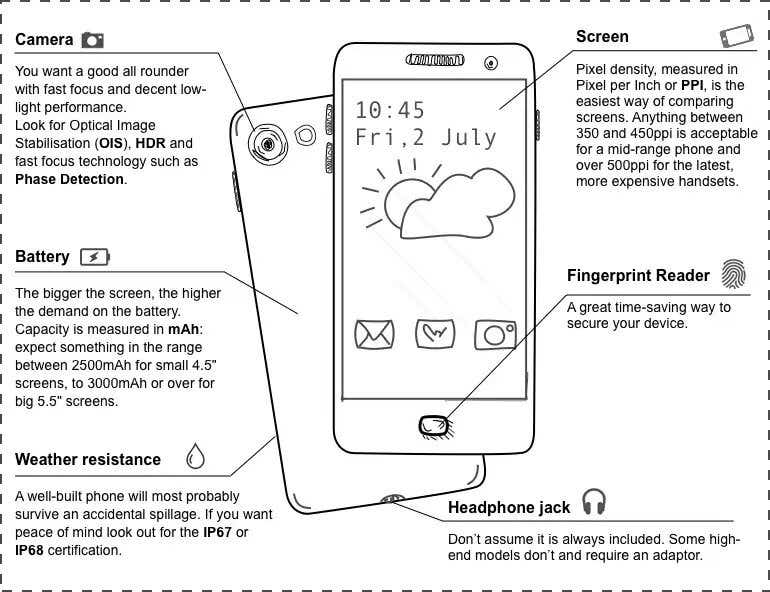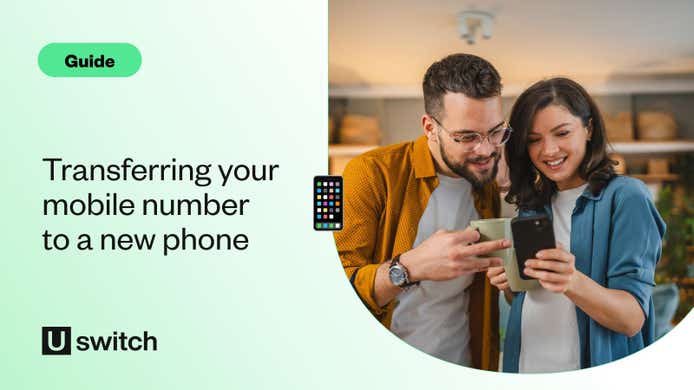Modern smartphones have long been separate from the home phones we grew up with, and they've replaced countless gadgets and in-person activities since coming to prominence in the 2000s.
You can use them to take excellent pictures, check email, surf the web, shop online, use social media, watch films and TV shows, play games, apply for jobs, do your online banking... the list goes on.
But before you do any of that, you need to buy the right smartphone for you. And that’s where we come in.
In this guide we’ll run you through the basics you need to know when buying your first ever smartphone, from what features you will need, what kind of camera you might want, the best operating system for your needs, how much you want to spend and what kind of accessories you might want.
Ready? Then let’s begin.
iPhone or Android?
These two types of phone use different 'operating systems', which is essentially what powers everything you do once you've turned the phone on. They have divided mobile phone fans all over the world over which is better: Apple’s iOS or Google’s Android?
In truth, it really depends on which you are used to. They largely work the same, with a series of homepages showing your apps arranged in a colourful, tile-based grid.
When one comes up with a new feature (like dark mode, which makes all your apps easier on the eye when viewed at night to ease eye strain and help you sleep) the other promptly implements something very similar, so you can rest assured you won’t be left behind.
The main issue is software updates, which bring you the latest features. Google’s Android runs on hundreds of phone models, which makes sending out software updates a bit of a challenge. So some models might not get the latest features until months after others.
The exception? Google’s Pixel range of Android phones. Because they’re made by Google (who makes Android), they’re the first to get new updates.
There are far fewer models of iPhone than Android phones, and they’re all made by Apple, so updates roll out quicker.
If you want to make sure you’re first to get the latest features, buy an iPhone, or one of Google’s Pixel Android devices.
Making sense of smartphone specs

Having to wade through acres of meaningless marketing phrases and impenetrable techy jargon seems to be par for the course when it comes to buying a smartphone.
With that in mind, in this section we make sense of all the specialist terminology you're likely to encounter and give you the information you need to sort the trash from the treasure.
Camera
Smartphones generally have a minimum of two cameras: one rear camera for general photography and video, and one front-facing lens for selfies and video calls.
But if you see a phone marketed as ‘dual camera’ or ‘triple camera’, it means it has two or three cameras respectively on its back.
"What’s the point of that?", you might ask. Different lenses serve different purposes. A wide-angle lens will be great for panoramic snaps, while a telephoto will let you zoom in from a great distance.
So the more rear lenses a phone has, the more shooting options you will have, and the better your photos will come out.
If you're keen to get the best photos possible, check out our guide to the best camera phones.
Screen
Pixel density, measured in pixels per inch (PPI), is the easiest way of comparing screens. In general, the more pixels packed into a screen the sharper the images.
Something between 350 and 450ppi (Pixel Per Inch) is acceptable for a mid-range phone. For the latest, more expensive handsets you can expect 500ppi or so.
Battery
Keeping your screen lit up saps your battery almost as much as using GPS or multi-tasking (for example: playing a game on your phone, while downloading TV shows and streaming music simultaneously).
With that in mind, it shouldn't surprise you that the bigger the screen, the more it saps your battery.
Battery capacity is measured in mAh: look for something in the range between 2500mAh for phones with smaller 4.5" screens. Then keep an eye out for 3000mAh or over for handsets with big 5.5" screens.
Check out our pick of the phones with the best battery life.
Water/dust resistance
A well-built phone will most probably survive an accidental spillage.
But if you work (or play) outdoors or in dusty environments look out for the IP67 or IP68 certification.
It means the device can survive being immersed in water. So is a good choice if you're accident-prone.
Fingerprint security
A fingerprint reader is usually embedded in a home button or a screen. Swipe your finger across it or press down and it'll recognise your unique fingerprint and unlock it.
As well as adding an extra layer of security, they're a great time-saving device. You'll find them on most top-end and mid-range phones, though some now favour facial recognition unlocking over a fingerprint scanner.
Accessories
Smartphones are so versatile you really don’t need many accessories. But you’ll want to know that the ones you do want are available to you.
You’ll want a decent selection of cases, for example, so you can keep your phone safe while helping it look its best.
The most popular models of phone have the most accessories, giving you the best choice. These are Apple iPhones, Samsung Galaxy handsets and Google Pixel phones.
Of course, it could be that your current phone of choice has a case that fits the bill perfectly. But do your research before you buy, so you’re not left with a smartphone inside a case that either a) doesn’t protect it well enough, or b) you don’t like the look of.
Now you know what to consider, what are some of the best phones available right now?
Headphone socket
Don’t assume all phones have a headphone socket.
Some manufacturers, such as Apple and HTC, don't use them. Hence you're forced to plug your headphones into the charging port with a special adaptor, which is easily lost.
It's either that, or shell out for a pair of wireless headphones, or ones that connect to whichever port the phone does have - usually USB-C (Android) or Lightning (iPhones).
The lesson? Check before you buy.
Premium performance at cut-price cost: iPhone SE
If you want an iPhone without a hefty price tag, the 2022 version of the iPhone SE is for you. The revamped iPhone SE has the classic iPhone 8 design – complete with a physical home button – but includes a more powerful A15 Bionic chip.
There are some compromises. The SE’s 4.7-inch screen is much smaller than the iPhone 11’s 6.1-inch, so games and films won’t look quite as stunning. But many will find the smaller size easier to handle.
It also only has one rear camera, so won’t give you quite as much photographic power as its more expensive stablemate. But with a saving of over £300, that’s a sacrifice many will be happy to make.
Into the midrange: Google Pixel 6a
Google Pixel phones have some of the best specifications on the market, and the Pixel 6a offers a mixture of some their best without the top-level price tag.
A great processor that makes everything run smoothly, a fantastic main camera, 5G connectivity and the latest version of Android. While it doesn't have fast charging or a top-notch display like its big brother the Pixel 6 Pro, it does have plenty of premium features for a fair price.
Hitting the high-end: Samsung Galaxy S23 Ultra
If you want the best of the best, the Samsung Galaxy S23 Ultra is for you. It has a huge 6.8-inch screen, tons of power and one of the best cameras around. Five of them, in fact.
It also has 5G, which gives you super speedy web browsing and download speeds where available.
It’s not cheap, but then this level of quality rarely is. So if you're happy to spend a lot of money on a lot of premium features, this phone might be right for you.
See our best Samsung Galaxy S23 Ultra deals.
Replace your camera: Sony Xperia 1 IV
Sony is well known for its digital camera technology, much of which it has incorporated into its Sony Xperia range. With Zeiss glass, variable focal length lenses and intricate manual controls, the Sony Xperia 1IV is an ideal choice for any photography enthusiast.
See our best Sony Xperia deals.
Or go retro: Nokia 3310
If that’s all a bit much for you, you could always go old school with a retro-tastic Nokia.
The 3310 is the classic handset we all remember, complete with the iconic Snake game that was the talk of the classroom in the late 90s.
It’s a feature phone, so is less advanced than the other handsets here, but you can still surf the web and send text messages. Just don’t expect the latest apps and games.
But it’s cheap as anything. And with a battery that’ll last a whopping 25 days, there’s a lot more to it than just retro charm.
What are most popular phone brands?
Apple iPhone
Apple produces amazingly well-designed and durable smartphones with a vast array of high quality of apps to choose from. But they're not cheap.
They don't often come with the highest-end specs on the market, but they're famous for offering one of the best all-round experiences on a smartphone. Their cameras, while they don't have the highest megapixel count, are sharp, offer great colour range and are perfectly social media-ready. There's a reason you can often tell when someone is using an iPhone for their Instagram stories.
iPhones also have a reputation for being much simpler to use than other handsets, thanks to their intuitive operating system and great integration with other Apple products. Those who have other devices made by Apple will benefit hugely from Apple's 'ecosystem', which lets you seamlessly share information and multitask across all of your devices at the same time.
Samsung Galaxy
Samsung's top-of-the-range devices pack all the latest technology at a price point similar to Apple's.
A safe bet if you just want the best Android phones on offer.
We'd recommend that, provided you have the budget, you should stick to the Galaxy S series and avoid their cheap, mid-priced phones.
We've found they tend to make compromises on quality and specs while somewhat maintaining Samsung's premium price tag.
If you want to save money, it's smart to go for last year's Samsung top-of-the-range phone. That way you get the premium feel and attention to detail, but you won't pay a premium price.
Google Pixel
The founders of Android themselves, you'd expect nothing short of perfection from a Google Pixel handset. And the Pixel range comes pretty close, with great specs, fast and efficient processor and one of the best cameras on the market.
Unfortunately, the less-than-popping screen lets this range down slightly and the design is more than a little outdated in a world where we expect borderless edge-to-edge displays. But they're still fantastic all-round phones. And if smartphone photography is important to you, a Pixel will do you proud.
Compare Google Pixel phone deals.
Sony Xperia
Although not quite as popular as they were a few years ago, Sony Xperia phones are solid handsets that integrate well with other Sony products and score highly for their screens and cameras.
That's largely due to Sony incorporating features from its Bravia TVs and dedicated digital cameras into its range of phones.
Its recent Xperia 1 experimented with a very tall design, and was generally very well received. But like the firm's other products, it doesn't come cheap.
OnePlus
OnePlus is a Chinese start-up that's made a real splash in a short time, having only entered the market with its first handset, the OnePlus One, in 2014.
It's now perhaps the best alternative to the high-street names.
The company's hallmarks include an exclusive version of Android, dubbed Oxygen OS, that offers more scope for you to customise the look, feel and layout of your phone.
Generally, OnePlus phones are cheaper than rivals but with comparable key features and a premium build quality.
Because they're typically up to a couple of hundred of pounds cheaper than rival top-end phones, many people choose to buy OnePlus handsets outright, then sign up for a keenly priced SIM-only deal.
Motorola
Once best known for its range of RAZR flip phones, Motorola now specialises in good-value handsets, the cheapest of which can be bought new for well under £200. It also relaunched the RAZR, complete with a foldable screen.
Most Motorola phones might not be the slickest on the market. But they're well constructed and easy to use.
And if you buy direct from Motorola, you can find some special offers and customisation offers.
As with OnePlus phones, it makes most financial sense to buy a Motorola outright. And then use our SIM only deals comparison tables to find a well priced SIM only deal.
Honor
Honor is owned by Huawei and specialises in mid-range and budget phones that are generally very warmly received on tech sites.
Like OnePlus, its phones undercut the household names by a few hundred pounds or so and focus principally on core features, such as the camera and the screen.
Need some help choosing a tariff too? Head to our guide for all the help you need.



